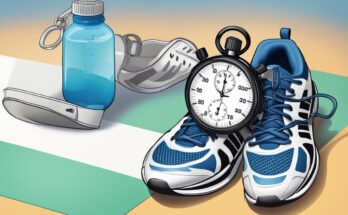Strength training is an essential component of a runner’s routine, often underestimated in its capacity to enhance running performance. While many runners focus predominantly on cardiovascular exercises, incorporating strength workouts offers numerous benefits, including improved running efficiency, reduced risk of injury, and strengthened muscles and joints. It involves exercises that are designed to improve the muscular force and endurance that runners need to maintain form, speed, and power over distances.

Runners have specific strength training needs that differ from those of other athletes. Their regimen typically targets key muscle groups such as the quadriceps, hamstrings, calves, and gluteal muscles, all of which play pivotal roles in the act of running. Strength training for runners should also focus on developing core stability to support the spine and pelvis during both the stance and swing phases of the running gait cycle.
When runners engage in strength training, they should aim for a balance between developing power and avoiding excess muscle bulk, which could potentially impact running performance negatively. The use of bodyweight exercises, free weights, and resistance bands can contribute to a runner’s ability to withstand the repetitive impact inherent in running, by fortifying muscles and connective tissues. Accordingly, a well-structured strength training plan can lead to improved running mechanics, increased muscular endurance, and overall higher performance levels.
Benefits of Strength Training for Runners
Strength training plays a crucial role in optimizing a runner’s performance by enhancing various physical components necessary for running. These improvements translate into better running economy, increased speed, greater endurance, and fewer injuries.
Enhancing Running Economy
Incorporating strength training into a runner’s regimen is shown to improve running economy. This is because strength exercises lead to more efficient movement patterns and better neuromuscular coordination. By increasing lean muscle mass, runners consume less oxygen at a given pace, which can improve their VO2 max — a key indicator of aerobic fitness.
Increasing Running Speed
Strength training contributes to a noticeable increase in a runner’s speed. This is achieved through explosive strength exercises that build fast-twitch muscle fibers, which are essential for sprints and fast starts. The improved muscular power allows runners to cover more distance with each stride, thus reducing the overall time needed to complete a run.
Improving Endurance
Runners who engage in regular strength training often experience improvements in their endurance. Muscle strength and endurance workouts help delay the onset of fatigue, allowing runners to maintain their pace for longer periods. This stamina translates to better performance in longer races and more intense workouts.
Reducing Injury Risk
One of the most significant benefits of strength training for runners is the reduction of injury risk. Strengthening muscles and connective tissues increases bone density and enhances joint stability, which mitigates the risk of common running-related injuries. Moreover, a well-designed strength routine can correct muscle imbalances, reducing the chances of overuse injuries — a prevalent issue among runners.
In summary, strength training offers a comprehensive range of benefits that help runners boost their performance, increase calories burned per run, and protect their bodies from injuries. With a consistent strength training routine, runners can expect to see tangible improvements in their running abilities and overall fitness level.
Understanding the Runner’s Body

The runner’s body is a finely tuned instrument where each muscle group plays a crucial role in performance, and a strong core provides the essential stability needed for efficient movement. Recognizing how muscular balance contributes to form and endurance is vital for a runner’s training.
Muscle Groups Relevant to Runners
Leg Muscles: The most important muscle groups for runners are the quadriceps, hamstrings, calves, and glutes. The quadriceps, located at the front of the thigh, are responsible for extending the knee during the running stride. The hamstrings, found at the back of the thigh, work with the quadriceps to control speed and power. Calves generate the push-off force during toe-off, impacting stride length and frequency.
Glutes and Hips: The gluteal muscles provide hip extension and play a significant role in stabilizing the pelvis. Strong hip muscles are essential for maintaining alignment and reducing the risk of overuse injuries.
- Quadriceps: Knee extension
- Hamstrings: Knee flexion and hip extension
- Calves: Ankle flexion and push-off
- Glutes: Hip extension and pelvic stability
Role of Core Stability in Running
Core Strength: A strong core, which includes the muscles of the abdomen, lower back, hips, and pelvis, is the foundation for a runner’s form. It facilitates energy transfer between the upper and lower body and maintains alignment during movement.
- Crucial Core Muscles:
- Rectus Abdominis: Forward spine flexion
- Obliques: Rotation and lateral flexion
- Erector Spinae: Spine extension and rotation
- Hip Flexors: Hip flexion
The core’s ability to resist unwanted motions is as important as its ability to initiate movement, making core stability a key component in reducing injury risk and increasing efficiency.
Impact of Muscular Balance on Performance
Muscular Balance: Balanced strength across the muscle groups is essential for optimal performance. Imbalances can lead to a poor running economy, slower times, and increased injury risk. Runners should aim to maintain symmetry in muscle strength, flexibility, and body composition to perform effectively.
- Examples of Imbalances:
- Dominant quadriceps over weaker hamstrings can cause knee issues.
- Weak glutes may lead to overcompensation by smaller muscle groups.
By addressing muscle imbalances through targeted training, runners can ensure their bodies are as efficient and resistant to injury as possible. Strengthening weaker muscles and ensuring flexibility in tighter areas contributes to a more harmonious and effective running mechanism.
Fundamentals of Strength Training

Strength training for runners focuses on enhancing performance and preventing injury. It is tailored to fortify specific muscle groups, improve balance and stability, and adapt the tendons and ligaments for the demands of running.
Designing a Runner-Specific Training Plan
A well-structured strength training plan for runners should address both the specific needs of the sport and the individual characteristics of the runner. It is crucial to incorporate a dynamic range of exercises that target key muscle groups such as the legs, core, and back. Beginners especially should start gradually, scaling up intensity and complexity with guidance from a personal trainer if possible. The plan should also ensure a balance between running sessions and strength workouts to prevent overtraining.
- Sample Training Plan Structure:
- Monday: Lower Body Strength
- Wednesday: Core and Stability
- Friday: Upper Body and Back
Proper Exercise Form and Technique
Adhering to proper form and technique during strength training is crucial for maximizing benefits and minimizing injury risk. Runners should focus on controlled movements and correct posture while lifting weights or performing resistance exercises. Every session should begin with a warm-up to prepare the muscles and joints for the workout. It is often beneficial to work with a personal trainer who can provide real-time feedback on exercise form.
- Key Techniques:
- Keep the spine aligned during lifting.
- Engage the core to support the lower back.
- Move through a full range of motion without compromising form.
Assessing Training Intensity and Volume
A runner’s perceived exertion level is a valuable indicator for assessing the intensity of strength workouts. Training should be challenging yet sustainable, and the volume must align with their current fitness level and running workload. A combination of repetition counts, weights used, and rest periods between sets can be adjusted to tailor the training intensity. Regular assessments help in fine-tuning the training plan, ensuring progression without undue fatigue or injury.
- Intensity Guidelines:
- Light: Can perform more than 15 reps per set with good form.
- Moderate: 10-15 reps per set with moderate effort.
- Vigorous: Less than 10 reps per set with high effort.
Employing these fundamentals enables runners to construct a strength training regimen that supports their overall running performance, contributing to speed, power, and endurance on the track or road.
Essential Strength Training Exercises
Strength training enhances a runner’s performance by improving endurance, power, and speed. It involves targeting various muscle groups to build a strong, injury-resistant physique. The following exercises are designed to optimize a runner’s strength and stability.
Core and Stability Work
Core strength is crucial for maintaining proper running form and balance. Planks are a fundamental exercise that engages the entire core, including the abdominals, back, and hips. To perform a plank, one must maintain a straight body line from head to heels while resting on their forearms and toes. Runners should aim to hold the position for at least 30 seconds, gradually increasing the duration.
For additional stability and hip strength, hip abduction exercises can be performed using resistance bands. To do this, runners can place a resistance band around their legs just above the knees and, while standing, move their leg sideways against the band’s resistance. This exercise targets the outer thigh and gluteal muscles, which are vital for lateral movement control.
Legs and Lower Body Exercises
Strong legs are the foundation of a powerful stride. Squats, which can be done with or without dumbbells, are effective for working the quadriceps, hamstrings, and glutes. To execute a proper squat, runners should stand with their feet shoulder-width apart, bend their knees, and lower their hips as if sitting back into a chair, then press back up to the starting position.
Lunges are another key exercise for developing leg strength and stability. These target the same muscles as squats but also improve balance. To perform a lunge, one steps forward and lowers their body until both knees are bent at a 90-degree angle, then pushes back up to the start.
Deadlifts strengthen the posterior chain, which includes the hamstrings, glutes, and lower back. Using a barbell or dumbbells, runners keep their back straight, bend at the hips and knees to lower the weight towards the ground, then return to standing, driving through their heels.
Upper Body and Back Strengthening
A strong upper body supports a steady running posture and aids in arm swing. Dumbbell rows can be done to strengthen the back muscles. In a bent-over position with one knee and one hand on a bench for support, runners lift a dumbbell towards their hip, keeping their elbow close to their body.
For overall upper body strength, including the chest, shoulders, and arms, push-ups are an invaluable exercise. Runners should begin in a plank position and lower their bodies until their chest nearly touches the ground, then push back up to the starting position, maintaining a strong core throughout the movement.
Implementing these exercises into a regular training routine will help runners build critical muscle groups, improve balance, and enhance overall running economy.
Advanced Strength Training Techniques
Advanced strength training techniques can play a crucial role in improving a runner’s performance by focusing on balance, stability, and neuromuscular coordination. These techniques involve a progression from intermediate exercises to more complex movements using various resistance equipment.
Incorporating Dynamic Movements
Dynamic movements are essential to enhancing a runner’s explosive power and coordination. They typically involve multi-planar motion and can include exercises like plyometric jumps and medicine ball throws. For balance and stability, runners may engage in activities like single-leg squats and Bosu ball exercises, which require the body to adapt to unstable conditions, thereby improving proprioception.
- Examples of Dynamic Movements:
- Plyometric jumps: Box jumps, jump squats, and bounding
- Medicine ball exercises: Rotational throws, slam, and overhead toss
Utilizing Various Resistance Equipment
Runners can leverage an array of equipment to intensify their strength training. Resistance bands provide a versatile option for resistance training, offering various levels of difficulty and aiding in the development of strength throughout the full range of motion. Free weights, including dumbbells and barbells, allow for a wide range of weightlifting exercises that can build muscle strength and endurance. Kettlebells are particularly useful for compound movements that improve both strength and neuromuscular coordination.
- List of Resistance Equipment:
- Resistance bands: Light, medium, and heavy for adaptable tension levels
- Free weights: Dumbbells and barbells for targeted muscle strengthening
- Kettlebells: Used for exercises like swings, goblet squats, and Turkish get-ups
Progression Strategies for Experienced Athletes
Experienced runners should establish progression strategies to continue advancing their resistance training. An effective progression plan might involve increasing weights, modifying sets and repetitions, or introducing more complex exercises. Emphasis should be placed on maintaining proper form and ensuring systematic progression to mitigate the risk of injury.
- Progression Techniques:
- Load increase: Gradually adding weight while maintaining form
- Volume change: Adjusting the number of sets and repetitions
- Exercise complexity: Introducing advanced movements over time
Injury Prevention and Recovery
Injury prevention and recovery are critical components of a successful running program. Strength training can significantly contribute to mitigating the risk of injury and promote faster recovery by addressing specific vulnerabilities in a runner’s body.
Identifying and Addressing Muscle Imbalances
Muscle imbalances can lead to a higher risk of injury for runners. A strength and conditioning specialist can identify these imbalances through assessments and tailor a strength program to correct them. Key muscles to focus on usually include the hamstrings, calves, and the muscles supporting the shin and joints. A common approach involves unilateral exercises like single-leg deadlifts, which can help balance strength on both sides of the body, reducing the chance of overuse injuries.
Strength Exercises for Injury-Prone Areas
Exercises targeting areas prone to injury are vital in reinforcing the body’s resistance against the stresses of running. For instance, eccentric calf raises specifically strengthen the calves and connective tissue, potentially preventing shin splints. Hamstring curls, whether lying or standing, improve the endurance of the hamstrings, allowing them to support the joints better during long runs and periods of fatiguing.
Recovery Practices and Cross-Training Options
Recovery is equally important to prevent injuries and should never be overlooked. Implementing recovery practices such as active rest, incorporating low-impact cross-training activities like swimming or cycling, is beneficial. A physical therapist might recommend foam rolling and dynamic stretching to enhance flexibility and aid in the recovery of aching muscles and connective tissue, while also preparing them for the next workout session. Additionally, alternating high-impact running days with strength training can minimize continuous stress on the joints and muscles, facilitating long-term injury prevention.
Integrating Strength Training into Running Routine
Strength training complements running by enhancing endurance, form, and performance. When incorporated effectively, strength workouts contribute significantly to a runner’s speed, stride, and mobility, and can help reduce fatigue during long runs and marathons.
Balancing Load Between Running and Strength Training
Runners should carefully distribute their training load to prevent overtraining. A balanced training plan might involve strength training on non-consecutive days to allow for recovery. For beginners, two days of resistance training may suffice, while intermediate and advanced runners could aim for 2-3 days. This balance helps maintain running form and endurance without leading to excessive fatigue.
Optimizing Frequency and Timing of Strength Workouts
The optimal frequency of strength workouts varies, but they are generally most beneficial after hard running sessions or on easy days to allow for ample recovery time. Runners should focus on exercises that improve their running economy, such as squats and lunges, while also including workouts for upper body and core stability.
| Runner Level | Suggested Frequency |
|---|---|
| Beginner | 2 times per week |
| Intermediate | 2-3 times per week |
| Advanced | 3-4 times per week |
Measuring Improvement and Adjusting Workouts Accordingly
Monitoring progress is key; runners should track improvements in running speed, endurance, and resistance to fatigue. They should also assess whether mobility and stride have been positively affected. Adjustments to the training plan should be made based on these measurements, ensuring that the runner continues to develop without hitting a plateau or regressing.
Equipment and At-Home Training Options
Strength training is crucial for runners to improve running form and muscular endurance. This section provides information on utilizing bodyweight exercises and selecting home gym equipment.
Using Bodyweight for Strength Training
Bodyweight exercises are a practical starting point for runners looking to strengthen their muscles. These exercises can be performed anywhere, making them ideal for at-home workouts. Runners can leverage their body weight to target key muscle groups that are essential for improved running performance.
- Core workouts: Planks, bridges, and leg raises enhance core stability.
- Lower body: Squats, lunges, and calf raises improve leg strength.
- Upper body: Push-ups and tricep dips support overall balance and posture.
Such bodyweight routines promote muscular endurance, benefitting a runner’s form and efficiency.
Selecting the Right Equipment for Home Gym
When setting up a home gym, choosing the right equipment is vital. It eliminates the need for a gym membership and allows for flexible training sessions.
- Dumbbells: They are versatile and can be used for a range of exercises to build strength.
- Resistance bands: These provide varying levels of resistance and are useful for warming up muscles as well as resistance training.
- Kettlebells: Ideal for dynamic movements that enhance power and cardiovascular fitness.
It’s essential for runners to select equipment that complements their strength training goals, fits within their available space, and aligns with their budget.
Nutrition and Lifestyle for Optimal Performance
Proper nutrition and lifestyle habits are crucial for runners looking to enhance their performance, optimize running economy, and maintain lean muscle mass. Managing calorie intake and stress levels, alongside other lifestyle adjustments, supports their training goals and entire body health.
Dietary Considerations for Runners
Runners require a diet that supports increased energy demands and nurtures body composition. They should consume calories sufficient to fuel their workouts while maintaining or building lean muscle mass. A balanced intake of macronutrients is essential:
- Carbohydrates: The primary source of energy, aiding in glycogen storage for endurance.
- Proteins: Essential for repairing and building muscle tissue.
- Fats: Necessary for long-term energy, vitamin absorption, and overall health.
Important micronutrients include iron for oxygen transport and calcium for bone health. Hydration cannot be overemphasized; runners need to replenish fluids to maintain performance and aid in nutrient transport.
Importance of Sleep and Stress Management
Sleep is paramount for recovery, and runners should aim for 7-9 hours nightly. Quality sleep allows the body to repair muscle tissue and supports immune function. Managing stress is equally important to prevent the release of hormones that can be detrimental to muscle recovery and mood. Techniques like mindfulness, yoga, or deep breathing exercises can help in reducing stress levels.
Lifestyle Adjustments to Support Training Goals
Runners should incorporate strength training into their routine to improve running economy and reduce injury risk. Cross-training, such as swimming or cycling, works different muscle groups and gives joints a break from the impact of running. Time management is also key, ensuring that runners have scheduled periods for both training and rest to optimize their entire body health and function.




